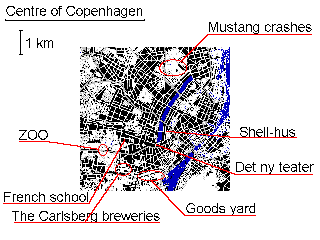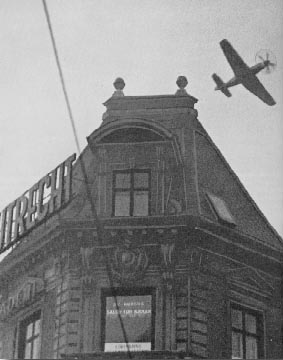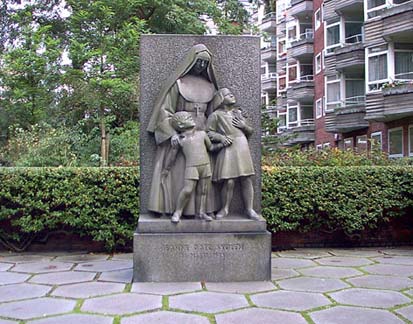Called one of the most accurate bombing missions of the Second World War, it left the Gestapo headquarter as a blazing inferno.
by Klaus Velschow
The Shellhus, or in English the Shell-building, was (and still is) situated near the centre of Copenhagen, 500 metres west of the Town hall. It is on the north side of Kampmandsgade between Nyrupsgade and Vester Farimagsgade (see map at right). Since the spring of 1944 the German secret police (Gestapo) had used it as headquarters.
In the fall of 1944 several cells were established on the top floor to minimize transportation of prisoners from Vestre faengsel (a large prison in Copenhagen) to interrogation and torture in the Shellhus.
By the end of 1944 the resistance-movement in Copenhagen was in danger of being rolled up by the Gestapo. Many of the leaders had been arrested and a lot of material was filed in the archives of the Shellhus. Leading members of the resistance-movement requested an attack by air on the Shellhus via SOE in London. By December 1944 the plan was ready, but the German counter attack in the Ardennes stopped the attack.
By the end of january 1945 the RAF was ready, but the attack was postponed probably due to the weather. In the middle of March the situation for the resistance-movement became intolerable. A desperate telegram was sent to London beggin for an attack: If the resistance-movement was at all important the RAF had to attack at all costs.
On march 21st at 0855, 20 Mosquitos of the no. 2 light bomber group, escorted by 30 Mustangs from the 11th fighter group took off from RAF Fersfield in Norfolk. 18 of the bombers were Mosquito F.B. Mk. VI and 2 were Mosquito B. Mk. IV from the film production unit (FPU).
The bombers carried 44×500 pound bombs. The Mustangs were Mk III’s. The formation arrived at Tissoe, a lake in western Zeeland, and split up in three waves: no. 1: 7 Mosquitos (one FPU) and 12 Mustangs, no. 2: 6 Mosquitos and no. 3: 7 Mosquitos (one FPU). Apparently the three waves took different routes to Copenhagen, although they all approached Copenhagen from the south-west.
The plan was to find the city of Koge some 30 km (20 miles) south of Copenhagen, then turn and follow the coast to Avedoere where they would turn north towards the Carlsberg brewery, passing it on the East-side. The last checkpoint was “Det Ny Teater”, a theatre on the southeastern corner of the most southern of the four lakes. From the theater the planes would attack the Shellhus from the south.It was only the first wave that followed the planned approach. The two following waves took a more direct course to Copenhagen. The third wave came in from west instead of south.
When the first wave passed the goods yard one of the Mosquitos hit a 30 metre lamp post and crashed near the French school (see the map). The rest of the wave found and bombed the target. The second wave got confused by the smoke and flames from the crashed Mosquito. Some realized the mistake before they bombed and turned toward the Shellhus, but only one of the planes were able to bomb the target.
One or two of the planes in the 2nd wave dropped their bombs on the French school. The third wave approached Copenhagen from the west, passing the ZOO on their way in. All but one of the planes in the third wave dropped their bombs on the French school killing 123 civilians of whom 87 were children.The Shellhus was hit by 8×500 pound bombs, 6 in the western wing towards Nyropsgade, and 2 in the eastern wing towards Vester Farimagsgade. The west wing collapsed and a fire started. It was a windy day: 12 metres per second from west. The fire spread to the rest of the building and it burned down.
At the time of the attack 26 members of the resistance were in the Shellhus: 23 in their cells on the top floor and 3 under interogation on the 5th floor.
The attack has always been seen as a succes because of the many surviving prisoners. Some accounts of the attack state that the bombers targeted the lower parts of the building, trying to avoid damage to the cells on the top floor.
The reason for the targeting of the lower parts could be the obvious, that the planes aimed at the centre of the building to be sure to hit some of it. As the author of one of the books about the attack points out: “No pilots, not even the best of RAF, were able to destroy a concrete building without destroying the upper floors.” (1)
The reason why so many (18 of 26) prisoners survived is probably that relatively few bombs hit the building. As mentioned above, 6 bombs exploded in the western wing. There were 9 prisoners in this part of the building, 6 were killed instantly and one more died when jumping from the 5th floor to the ground.
All 14 prisoners in the southern wing survived (no bombs hit this part of the building). The 3 remaining prisoners were under interrogation on the 5th floor, one died. There were no prisoners in the eastern wing. The German casualties were around 50 Germans and 50 Danes who worked for the Gestapo.
Of the 20 Mosquito’s taking part in the attack 16 returned. One crashed in the goods yard before bombing and three more were shot down off the coast of northern Zeeland after the attack. 3 Mustangs had to turn around shortly after takeoff.
1 Mustang crashed in a park north of the Shellhus. The primary objective for the fighters was to attack AA positions in central Copenhagen. 9 RAF pilots and crew were killed in the attack. 3 are buried at Bispebjerg kirkegaard the remaining 6 crashed over the sea and they were never found.
The Museum of Resistance (Frihedsmuseet) has on display one of the models of Copenhagen built and used by the RAF when they planned the attack.
The Shellhus today
The Shellhus of today is the head office of the Shell Oil Company in Denmark. Mounted on the wall of the building is a bronze-cast of a propeller from one of the crashed Mosquito bombers. Below the propeller is a plaque with the names of the RAF crews members who were killed in the attack.
Læs mere:
Ove Hermansen: Gruppen der bombede Shellhuset, Årsskrift for frihedsmuseets venner 1979.
Kleld Mahler Sasbye: OPERATION CARTHAGE, ISBN 87-985141-0-5
Henrik skov Kristensen, Claus Kofoed, Frank Weber:
Vestallierede luftangreb i Danmark under 2. verdenskrig, ISBN 87-7288-071-6
Books in English:
Michael F. Bowyer and Martin C. Sharp: Mosquito, Faber and Faber, London 1967, 494 pages (Paperback 1972)
Michael F. Bowyer and Martin C. Sharp: 2 Group R.A.F.- A Complete History, 1936-1945, Faber and Faber, London 1974, 532 pages
Mike Donnet: Flight for Freedom, Ian Allan, London 1971 ?? 177 pages (Could be one of the fighterpilots)
Basil Embry: Mission Completed, Methuen, London 1957, 350 pages (He was CO 2 bomber group and flew one of the Mosquitos over Copenhagen)
J. E. Johnson (“Johnnie”): Wing Leader, Chatto and Windus, London, 1956, 320 pages
Robin Reilly: The Sixth Floor, Leslie Frevin, London, 1969, 223 pages
Christopher F. Shores: 2nd Tactical Air Force, Osprey, England, 1970, 298 pages




